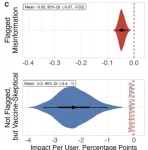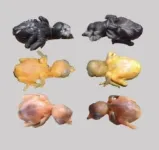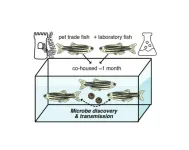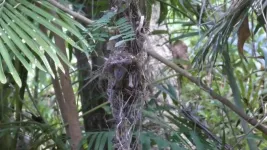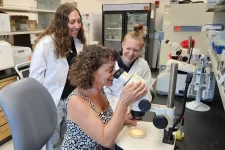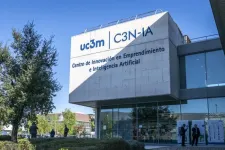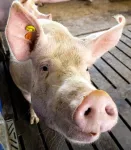(Press-News.org) What threatens public health more, a deliberately false Facebook post about tracking microchips in the COVID-19 vaccine that is flagged as misinformation, or an unflagged, factual article about the rare case of a young, healthy person who died after receiving the vaccine?
According to Duncan J. Watts, Stevens University Professor in Computer and Information Science at Penn Engineering and Director of the Computational Social Science (CSS) Lab, along with David G. Rand, Erwin H. Schell Professor at MIT Sloan School of Management, and Jennifer Allen, 2024 MIT Sloan School of Management Ph.D. graduate and incoming CSS postdoctoral fellow, the latter is much more damaging. “The misinformation flagged by fact-checkers was 46 times less impactful than the unflagged content that nonetheless encouraged vaccine skepticism,” they conclude in a new paper in Science.
Historically, research on “fake news” has focused almost exclusively on deliberately false or misleading content, on the theory that such content is much more likely to shape human behavior. But, as Allen points out, “When you actually look at the stories people encounter in their day-to-day information diets, fake news is a miniscule percentage. What people are seeing is either no news at all or mainstream media.”
“Since the 2016 U.S. presidential election, many thousands of papers have been published about the dangers of false information propagating on social media,” says Watts. “But what this literature has almost universally overlooked is the related danger of information that is merely biased. That’s what we look at here in the context of COVID vaccines.”
In the study, Watts, one of the paper’s senior authors, and Allen, the paper’s first author, used thousands of survey results and AI to estimate the impact of more than 13,000 individual Facebook posts. “Our methodology allows us to estimate the effect of each piece of content on Facebook,” says Allen. “What makes our paper really unique is that it allows us to break open Facebook and actually understand what types of content are driving misinformed-ness.”
One of the paper’s key findings is that “fake news,” or articles flagged as misinformation by professional fact-checkers, has a much smaller overall effect on vaccine hesitancy than unflagged stories that the researchers describe as “vaccine-skeptical,” many of which focus on statistical anomalies that suggest that COVID-19 vaccines are dangerous.
“Obviously, people are misinformed,” says Allen, pointing to the low vaccination rates among U.S. adults, in particular for the COVID-19 booster vaccine, “but it doesn’t seem like fake news is doing it.” One of the most viewed URLs on Facebook during the time period covered by the study, at the height of the pandemic, for instance, was a true story in a reputable newspaper about a doctor who happened to die shortly after receiving the COVID-19 vaccine.
That story racked up tens of millions of views on the platform, multiples of the combined number of views of all COVID-19-related URLs that Facebook flagged as misinformation during the time period covered by the study. “Vaccine-skeptical content that’s not being flagged by Facebook is potentially lowering users’ intentions to get vaccinated by 2.3 percentage points,” Allen says. “A back-of-the-envelope estimate suggests that translates to approximately 3 million people who might have gotten vaccinated had they not seen this content.”
Despite the fact that, in the survey results, fake news identified by fact-checkers proved more persuasive on an individual basis, so many more users were exposed to the factual, vaccine-skeptical articles with clickbait-style headlines that the overall impact of the latter outstripped that of the former.
“Even though misinformation, when people see it, can be more persuasive than factual content in the context of vaccine hesitancy,” says Allen, “it is seen so little that these accurate, ‘vaccine-skeptical’ stories dwarf the impact of outright false claims.”
As the researchers point out, being able to quantify the impact of misleading but factual stories points to a fundamental tension between free expression and combating misinformation, as Facebook would be unlikely to shut down mainstream publications. “Deciding how to weigh these competing values is an extremely challenging normative question with no straightforward solution,” the authors write in the paper.
Allen points to content moderation that involves the user community as one possible means to address this challenge. “Crowdsourcing fact-checking and moderation works surprisingly well,” she says. “That’s a potential, more democratic solution.”
With the 2024 U.S. Presidential election on the horizon, Allen emphasizes the need for Americans to seriously consider these tradeoffs. “The most popular story on Facebook in the lead-up to the 2020 election was about military ballots found in the trash that were mostly votes for Donald Trump,” she notes. “That was a real story, but the headline did not mention that there were nine votes total, seven of them for Trump.”
This study was conducted at the University of Pennsylvania’s School of Engineering and Applied Science, the Annenberg School for Communication and the Wharton School, along with the Massachusetts Institute of Technology Sloan School of Management, and was supported by funding from Alain Rossmann.
END
Reexamining misinformation: How unflagged, factual content drives vaccine hesitancy
2024-05-30
ELSE PRESS RELEASES FROM THIS DATE:
Novel virus identified in zebrafish from the pet trade causes disease in laboratory fish
2024-05-30
Zebrafish in the pet trade are asymptomatic carriers of previously undescribed microbes, including a novel virus that causes hemorrhaging in infected laboratory fish, Marlen Rice from the University of Utah, US, and colleagues report in the open-access journal PLOS Biology, publishing May 23rd.
Zebrafish (Danio rerio) are a common laboratory research animal, and they are also widely available as pets. In research laboratories, they are kept in specialized aquaculture facilities to prevent infectious disease, but zebrafish are occasionally ...
Cuckoos evolve to look like their hosts - and form new species in the process
2024-05-30
The theory of coevolution says that when closely interacting species drive evolutionary changes in each other this can lead to speciation - the evolution of new species. But until now, real-world evidence for this has been scarce.
Now a team of researchers has found evidence that coevolution is linked to speciation by studying the evolutionary arms race between cuckoos and the host birds they exploit.
Bronze-cuckoos lay their eggs in the nests of small songbirds. Soon after the cuckoo chick hatches, it pushes the host’s eggs out of the nest. The host not only loses all its own eggs, but spends several ...
Cause of heart failure may differ for women and men
2024-05-30
A new study from the UC Davis School of Medicine found striking differences at the cellular level between male and female mice with heart failure with preserved ejection fraction (HFpEF).
The findings could determine how HFpEF is treated in women compared to men.
With HFpEF, the heart muscle contracts normally but the heart is unable to fully relax and refill properly between beats. This condition is known as diastolic dysfunction. It can occur if the heart is too stiff or if the contraction process doesn’t shut off quickly enough between ...
Tiny worm helps uncover long-lasting prenatal effects from amphetamines
2024-05-30
Amphetamine is a psychostimulant that has been used to treat a variety of brain dysfunctions. However, it is a highly abused drug. In fact, amphetamine and amphetamine-derived compounds such as methamphetamine (Meth) are among the most abused psychostimulants in the world.
The neurological effects caused by acute or chronic use of amphetamine have been broadly investigated and several studies have shown that proteins involved in the synthesis, storage, release and reuptake of dopamine (DA), a neurotransmitter that plays a role as in ...
Banners backfire: Misinformation impact on search results
2024-05-30
ITHACA, N.Y. – Cornell University researchers have found in a public health emergency, most people pick out and click on accurate information during internet searches.
Though higher-ranked results are clicked more often, they are not more trusted. And the presence of misinformation does not damage trust in accurate results that appear on the same page. However, banners at the top of the search results page warning about misinformation decrease trust in accurate information, according to the research published in Scientific Reports.
The relationship between ...
UC3M is a shareholder of five of its researchers’ new spin-offs
2024-05-30
The Universidad Carlos III de Madrid (UC3M) has become a shareholder of five new companies recently set up and promoted by different researchers: Applied Innovative Methods, Hiili, Persei Space, Seevia Technologies and 60Nd.
UC3M participates in the share capital of its spin-offs in order to contribute to their business development. This minority and temporary shareholding is articulated in accordance with the regulations for the creation of knowledge-based university companies.
AI Methods, S.L., led by Manuel Soler ...
New method makes hydrogen from solar power and agricultural waste
2024-05-30
University of Illinois Chicago engineers have helped design a new method to make hydrogen gas from water using only solar power and agricultural waste, such as manure or husks. The method reduces the energy needed to extract hydrogen from water by 600%, creating new opportunities for sustainable, climate-friendly chemical production.
Hydrogen-based fuels are one of the most promising sources of clean energy. But producing pure hydrogen gas is an energy-intensive process that often requires coal or natural gas and large amounts of electricity.
In a paper for Cell Reports Physical Science, a multi-institutional ...
Credibility makes or breaks the price: political commitment in long-term climate policy key for effective EU emissions trading system
2024-05-30
“The price on emitting carbon that is harmful to the climate has risen sharply in the past; basically, it roughly increased tenfold over the last five years and two policy reforms. Our analysis implies that besides directly changing the ETS rules, the reforms also increased the long-term credibility of the EU ETS and thereby made firms more farsighted, aligning their market behaviour with long-term climate targets,” explains Joanna Sitarz, PIK scientist and first author of the study published in Nature Energy. “In ...
Slow-growth diet before breeding offered better long-range health in pigs
2024-05-30
FAYETTEVILLE, Ark. — Borrowing a page from the dairy industry, researchers with the Arkansas Agricultural Experiment Station found that a slow-growth diet meant more piglets and healthier and longer-lived momma pigs.
Slowing weight gain for female pigs before breeding showed improvements in performance throughout four breeding cycles, according to Charles Maxwell, professor of animal science for the experiment station, the research arm of the University of Arkansas System Division of Agriculture.
“Scientists have done a wonderful job of increasing litter size and milk production so that our sow lines are essentially ...
CHOP researchers develop easy-to-use screening tool to help improve family access to federal nutrition programs
2024-05-30
Philadelphia, May 30, 2024 – Researchers from The Possibilities Project and Clinical Futures at Children’s Hospital of Philadelphia (CHOP) developed, implemented and successfully tested a nutrition screener to improve access to healthy resources for families eligible for federally funded food benefits. The findings were published this week in the journal Annals of Family Medicine.
Many low-income families rely on the federally funded Special Supplemental Nutrition Program for Women, Infants, and Children ...
